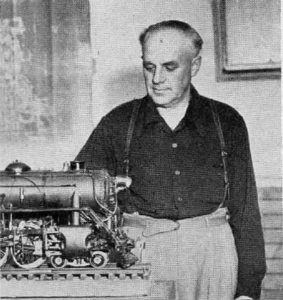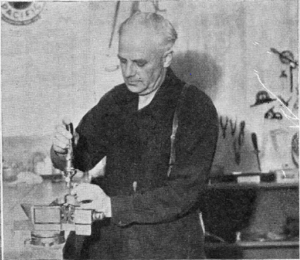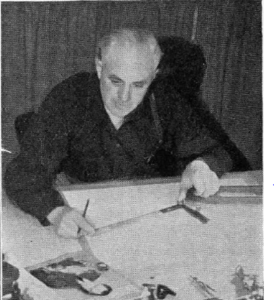Martin Lewis: Difference between revisions
| Line 37: | Line 37: | ||
As to our present line of engines, the latest is a 1/4 inch scale live steamer in two types - a 4-6-4 and a 4-8-4. We expect to bring out other models in the near future. | As to our present line of engines, the latest is a 1/4 inch scale live steamer in two types - a 4-6-4 and a 4-8-4. We expect to bring out other models in the near future. | ||
Previous to building No. | Previous to building No. 7777, I had built six locomotives, beginning with No. 1111. All but one were in 3/4 inch scale. | ||
Our decision to build O-gauge live steamers is in answer to the many requests we've had from readers who want one or more such locomotives to augment the realism of their electrically operated roads. Because of technical problems, considerable research was necessary in order to work out good, reliable 1/4 inch scale steamers. We found that certain units which operated perfectly in the larger models were inadequate for 1/4 inch scale without changes in design. | Our decision to build O-gauge live steamers is in answer to the many requests we've had from readers who want one or more such locomotives to augment the realism of their electrically operated roads. Because of technical problems, considerable research was necessary in order to work out good, reliable 1/4 inch scale steamers. We found that certain units which operated perfectly in the larger models were inadequate for 1/4 inch scale without changes in design. | ||
Revision as of 22:42, 3 September 2015
Martin Lewis was the founder of Little Engines.
- Martin Short Lewis, Jr. was born in 1885 in Iowa. In 1917 he lived in San Bernadino and was assitant manager of a Ford Agency. It appears that he moved to Lomita in the mid-1930s. Little Engines was apparently a going concern as early as 1940 as I have an early LE catalog that was prepared just before WWII.
- Martin S. Lewis died May 30, 1949. His widow, Irene, carried on the business for about another 30 years.
Little Engines
From The Model Craftsman, August 1940:
Story of Lewis Little Engines
By Martin S. Lewis
The start of Little Engines dates back to April, 1934, when I wrote the series for The Model Craftsman on the construction of No. 7777, a 3/4 inch scale 4-6-4 type live steam locomotive. This series ran for 15 months, describing the construction of the locomotive, step by step, from making the patterns for the castings to painting the completed model.
In fact, the articles dealt with the project - from the rails up - in detail, but in such a way as to need as few machine tools as possible in a model of this sort.
Immediately upon publication of the first of the series, we commenced getting letters from persons who did not care to make the necessary patterns for themselves for one reason or another, but who did want the castings. So we arrange to provide the castings.
Then came the question of bolts and nuts in miniature sizes. Boiler and pipe fittings, and various other parts in scale, too, were apparently much in demand. And our reader-builders seemed at a loss for a source of supply for these needed parts.
We immediately went to work on the problem. our first step was to obtain some of this material in the very quickest way possible - that way was by importation from European model factories. Then we started making them up ourselves.
Rail and fastenings were wanted more and more. We had an extrusion die made, from which duraluminum was extruded for us by the Aluminum Company of America. Then we had steel spikes and rail joints made. Tracking problems were further solved by our mahogany ties, the natural color of which resembled the creosoted ties of the big railway systems throughout America.
Having the various and many items in stock, it became necessary for us to get the articles and prices to our inquirers. This we did by publishing a 48-page catalog, showing castings, bolts, nuts, washers, metals - in fact, everything needed by the miniature live steam locomotive builders.
In this catalog, we provided our people with something much more than a mere list of supplies and materials. We included several pages of general information useful to the builders of working locomotive models of all types. This, we believe, has been incerely appreciated.
As to our present line of engines, the latest is a 1/4 inch scale live steamer in two types - a 4-6-4 and a 4-8-4. We expect to bring out other models in the near future.
Previous to building No. 7777, I had built six locomotives, beginning with No. 1111. All but one were in 3/4 inch scale.
Our decision to build O-gauge live steamers is in answer to the many requests we've had from readers who want one or more such locomotives to augment the realism of their electrically operated roads. Because of technical problems, considerable research was necessary in order to work out good, reliable 1/4 inch scale steamers. We found that certain units which operated perfectly in the larger models were inadequate for 1/4 inch scale without changes in design.
These problems, naturally, required experimentation - and patience - to work out. But now we feel we have the problems in design and construction worked out, and we're ready to pass our findings on to our readers.
It is our future plan to make our instructions clearer, and to add more and more detail. We wish to be a help to those who want to build miniature locomotives, but who know prototypes only by sight and sound. Those who know locomotives thoroughly do not need our help.
We like to think that we are putting our drawings and instructions in such form that they will enable the builder to complete his task with a minimum of difficulty. We like for our builder to use his own discretion, and go as far as he likes, in adding detail. Yet, if he adds no detail to that shown in our instructions, he will still have a fine-appearing and operating engine.
In order to carry out our program, we feel that we need the help of our readers. So, we'll appreciate it if you'll just write to us in care of The Model Craftsman whenever you desire information.



